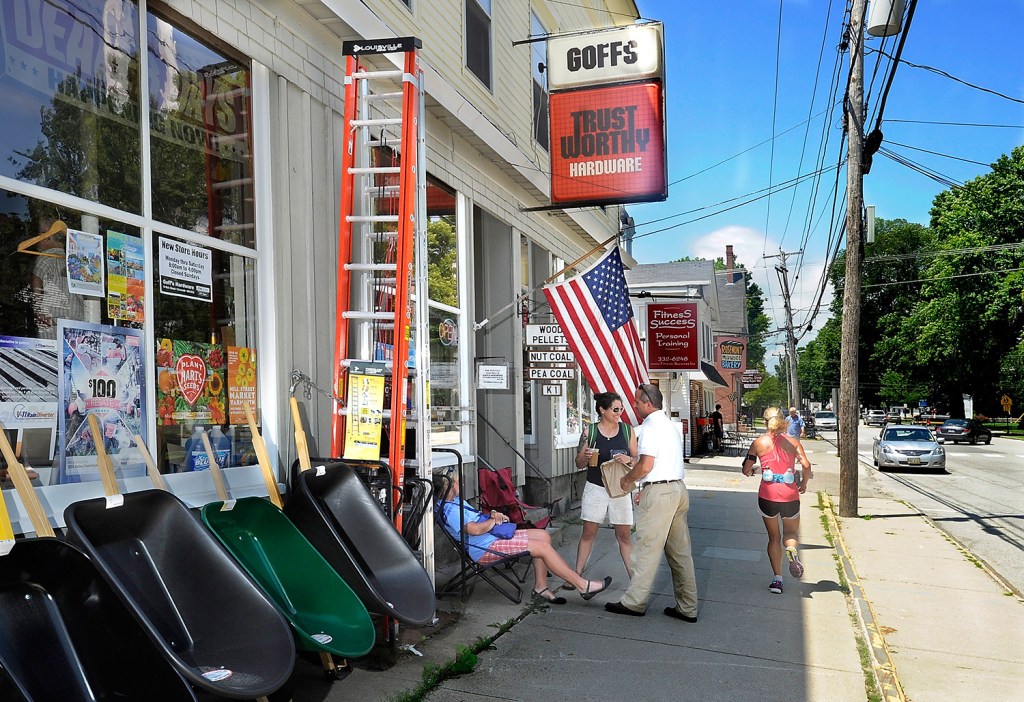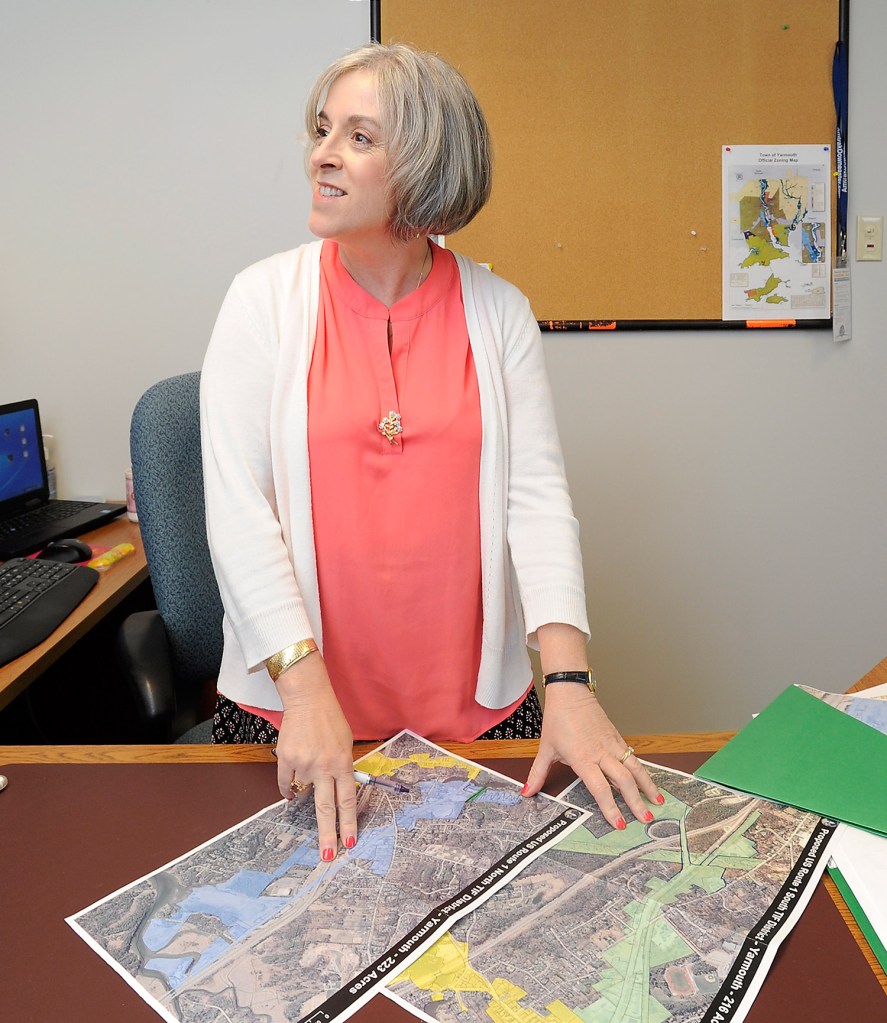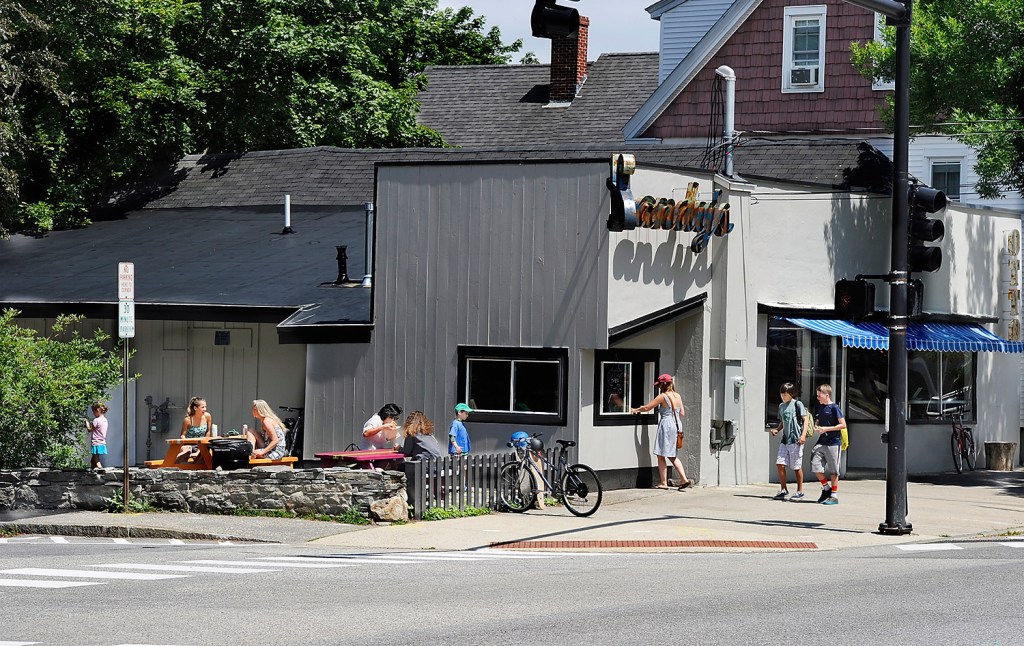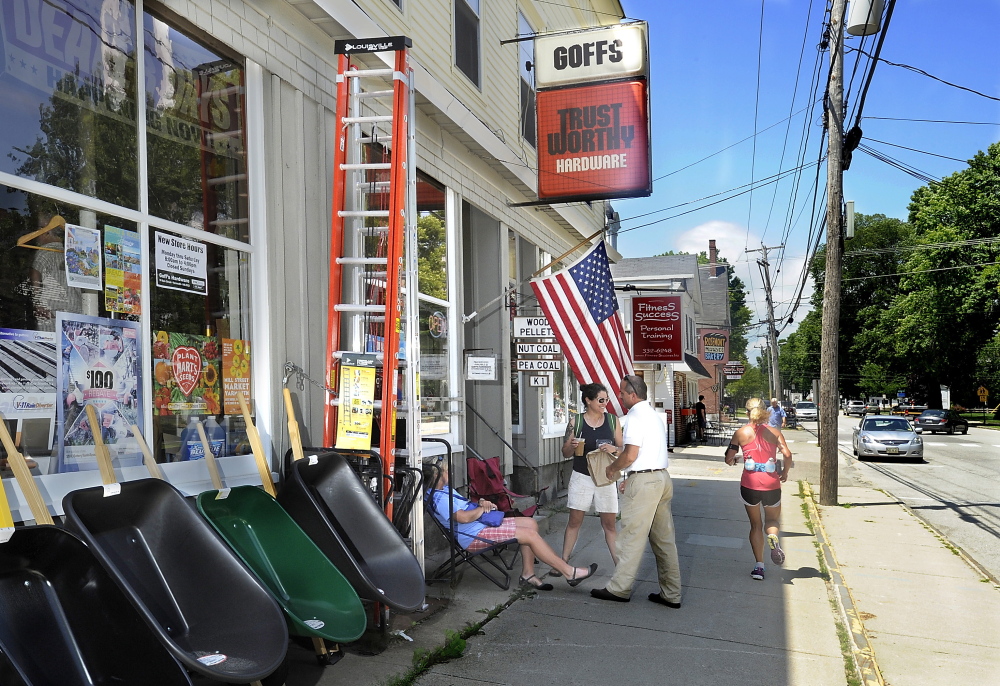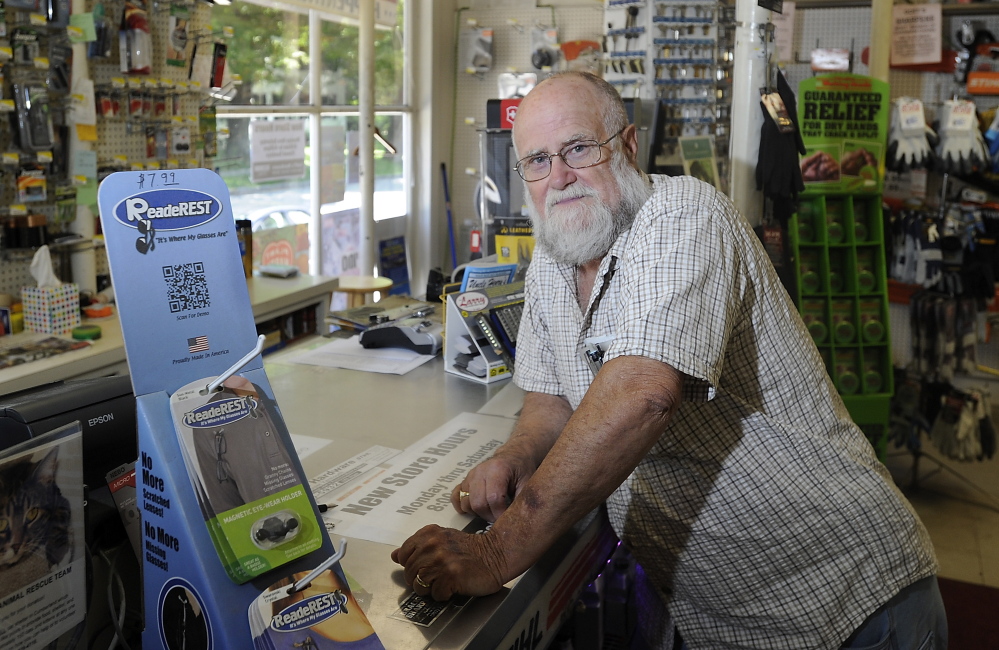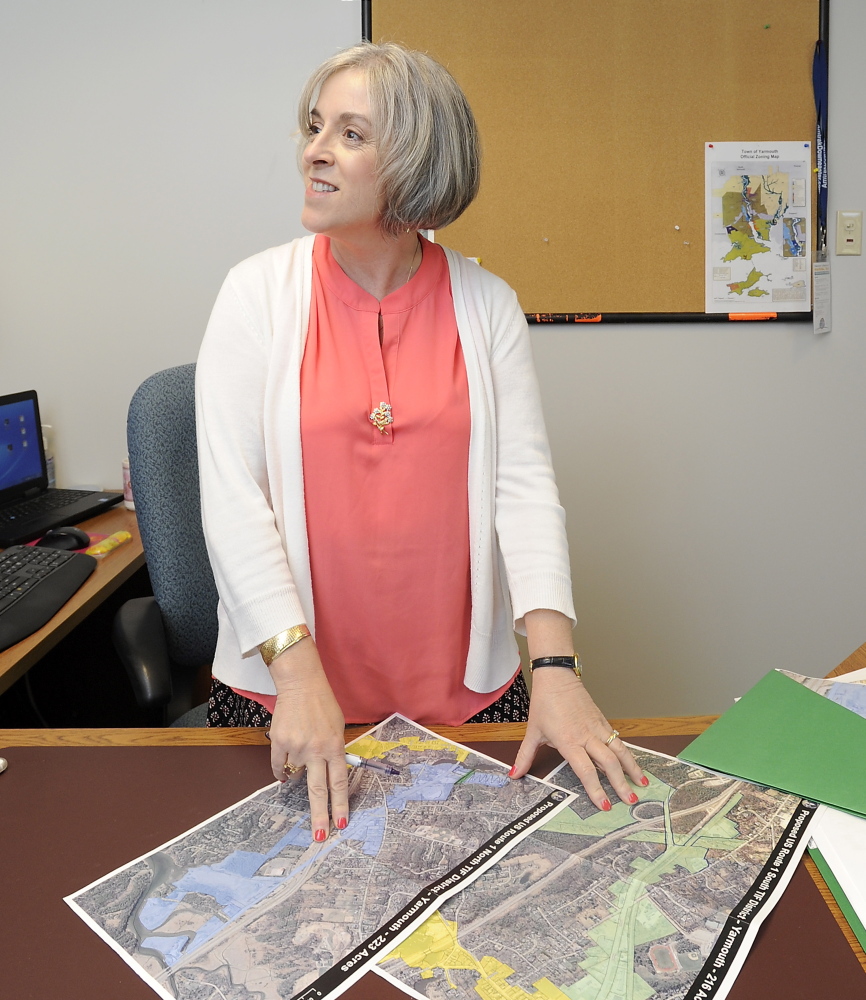YARMOUTH — When Butch Goff bought a dry goods store on Main Street in the late 1960s, the street was a vibrant village center where people lived, shopped and went to work. There were grocers, drugstores, lunch counters, gas stations and even a movie theater.
But over the years, Goff, who plans to retire this year and close his hardware store after 46 years in business, has watched Main Street’s star dim as the town’s business epicenter shifted to Route 1 with its strip malls and chain stores.
Now there’s little reason for someone to come to Main Street, Goff said. The 70-year-old waves his arm at the storefront’s large plate-glass windows to highlight the scant daytime traffic.
“You have more variety on Route 1 than you do on Main Street,” he said. “All your drugstores are up there, your grocery stores … the eateries … the hardware store is up there, a couple of filling stations are up there. Unless you wanted something really special, why would you come to Main Street?”
Goff’s question is not lost on others, especially Denise Clavette, who in January became Yarmouth’s first-ever economic development director. Her arrival signifies the town’s willingness to abandon the restrictive no-growth policies of the past and embrace a more open attitude about development.
In the short time that Clavette has been with the town, she’s overseen the creation of an economic development advisory board, prepared a plan to create three tax increment financing, or TIF, districts to help fund projects along Route 1 and Main Street, and is preparing a request for proposals for a market analysis to help guide the town’s economic development efforts.
Nat Tupper, Yarmouth’s town manager, said Clavette’s hiring and the other changes underway are ushering the town into a new era.
“Yarmouth acquired a reputation for being a difficult town to do business in and this is a clear sign that we want to change that,” Tupper said.
TURNING THE SHIP WON’T BE EASY
Clavette has her work cut out for her. Restrictive zoning ordinances prevent any new commercial construction along the town’s mile-long Main Street, a decision that redirected business activity to Route 1 and helped create stretches of strip malls and chain stores separated from the road by acres of parking lots. Working with the new advisory board and tapping her background as Portland’s director of parks and recreation, Brunswick’s director of business development and, most recently, director of the Kennebunk-Kennebunkport-Arundel Chamber of Commerce, Clavette wants to initiate a strategic and long-range economic development vision for the town.
And, along the way, diversify the town’s tax base.
When Tupper became town manager in 1991, Wyman Station, the oil-fired power plant on Yarmouth’s Cousins Island, represented 40 percent of the town’s tax base. Now it’s only 4 percent – partly because of a decrease in the assessed value of the power plant, which runs only a few times a year during peak electricity demand, and partly because of growth in the overall tax base. The tax rate in 1991 was roughly $17 per $1,000 of assessed valuation, and today it’s $21.60.
Although growth had plateaued for much of the 1990s and 2000s, it ramped up recently. Yarmouth’s school population has increased 9 percent in the past five years, Tupper said.
Those changes are forcing town leaders, including many fresh faces on the Town Council, to abandon the status quo, said Patrick Powers, a local real estate broker who moved to town in 1985.
“The biggest disadvantage we’ve had over the past 30 years was the mindset of the Town Council,” Powers said. “The whole need to diversify, the need to grow, was never there over those years because Wyman Station paid the bills.”
But how those changes will be enacted remains to be seen.
The draw of Yarmouth – a town of roughly 8,350 people just 10 miles north of Portland along the coast – has typically been its schools, consistently ranked as some of the best in Maine, and its quaint downtown village clustered along Main Street.
“People come to Yarmouth because they love Main Street,” said Powers. “Yarmouth is the only community between Kennebunkport and Bath that has a village center. It’s a true village community.”
After the town experienced two decades of steady growth – its population grew 60 percent during the 1970s and 1980s – the Yarmouth Town Council adopted restrictive zoning ordinances meant to protect the village’s character and the historic homes along its mile-long stretch, from the old Andy’s Handy Store, commonly known by locals as Handy Andy’s, in the northwest to Goff’s Hardware store in the southeast. The ordinances prevent the construction of new commercial buildings, for instance, and heavily restrict what a property owner can do to existing structures.
Powers said the restrictive zoning makes it hard to market a property to a buyer who wants to do anything but maintain the status quo.
“We were afraid of someone ripping down all the old houses and replacing them with bricks and glass,” Tupper said.
MORE LEEWAY IN MAIN STREET ZONING
But now the Town Council will consider new “character-based” zoning ordinances, where the form and scale of a development is considered in the context of place rather than just complying with land-use rules. The changes, if enacted, will provide more leeway to Main Street property owners and potential developers.
The town has some experience in that realm. In 2013, the Town Council approved “character-based” zoning ordinances for the Route 1 corridor that require any new construction or redevelopment to bring the buildings closer to the road and shift parking to the side and rear of buildings. Those requirements, coupled with future infrastructure improvements such as the addition of wider sidewalks and bike lanes, are designed to create a more attractive stretch of road and to entice drivers to slow down and notice local businesses.
Carolyn Schuster, executive director of the Yarmouth Chamber of Commerce, supports the new codes.
“If we develop Main Street right, people will come to it to do their shopping and walk along. I think it can be vibrant and I think it can thrive, but it needs to be done right,” Schuster said. “Hopefully, as we saw with Route 1 when that code was adopted, we’ll begin to see interest from the developers again.”
Matt Chappell, who successfully lobbied the Town Council to lift a 60-seat limit for restaurants on Main Street when he opened Gather three years ago, agrees.
“We can’t be so restrictive that nothing happens. You have to let it evolve in a smart way, and I think that’s where some of the new zoning comes in,” Chappell said.
Gather is often cited as evidence that Main Street is becoming more vibrant. Other bright spots include the arrival several years ago of Rosemont Market, a local market chain, into the old Donatelli’s spot on the corner of Portland and Main streets. The most visible recent change, however, has been the renovation of the old Handy Andy’s, which received a face-lift and now houses three businesses: Otto Pizza, Hilltop Coffee shop and a small high-end grocer.
TURNING A VISION INTO REALITY
Clavette, the economic development director, offers Brunswick as a good model for Yarmouth. Brunswick has a busy stretch of Route 1 with several gas stations, restaurants and motels, but it also has a vibrant and walkable main street, which is actually called Maine Street. Yarmouth doesn’t have a Bowdoin College at the end of its Main Street, but it’s a good example of what a walkable, destination-worthy downtown village can be.
Key to making that vision a reality, in Clavette’s estimation, is getting the character-based zoning ordinances adopted for Main Street and creating the three TIF districts. The TIFs will allow the town to capture new tax revenue from growth along Main Street or Route 1, and put the money in a development fund to finance infrastructure improvements related to economic development – from extending sidewalks farther along Route 1 to adding bike lanes. Although TIF districts are not the same as credit enhancement agreements, which can be used to lure businesses to a town by refunding some of their property taxes, the creation of TIFs gives the town that option. It was a TIF that previously helped Yarmouth retain DeLorme, a large map-making company.
Clavette is excited to be the first person in the town’s economic development chair, and “to be able to be in a place that’s ready for – ‘change’ is not the word, because I’m not sure they’re ready for change – is ready for a different view and a focused approach to economic development.”
Clavette will have help envisioning Yarmouth’s future. Alex Jaegerman, formerly Portland’s longtime planning director, will become Yarmouth’s new planning director on Wednesday.
Tupper said Yarmouth has “an extremely engaged community” and a challenging planning process. Jaegerman brings “maturity” and an experienced approach that will help the town manage the process going forward, he said.
ROUTE 1 CHANGES REACHING FRUITION
No new construction has happened since the Route 1 character zoning ordinances went into effect, but several projects are nearing that stage. The grocery chain Hannaford, which has a store on Route 1, had previously purchased a neighboring former church and recently tore it down to make way for new development. Powers recently sold an empty lot on Route 1 that was once home to the Brookside Motel. Powers wouldn’t reveal the buyer’s plans, but said they involve the construction of a commercial building.
Powers is also marketing for redevelopment the former Down East Village Restaurant and Motel, which sits on a 7-acre lot on Route 1. The property is listed for $2.2 million.
Anita Demetropoulos, the owner of Island Treasure Toys on Route 1 in Yarmouth and a member of the town’s new economic development advisory board, likes the new vision for Route 1, but cautions that it’s a long-range plan.
“There’s quite a bit going on, so little by little things will start to change, and I think for the better,” she said. “If there’s one thing you can count on in life, it’s change. And it doesn’t have to be bad. So you either embrace it or fight it. Who wants to fight it?”
Send questions/comments to the editors.

